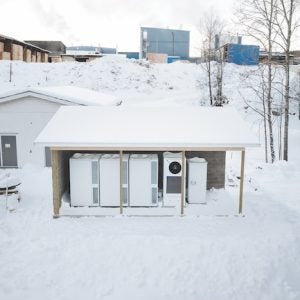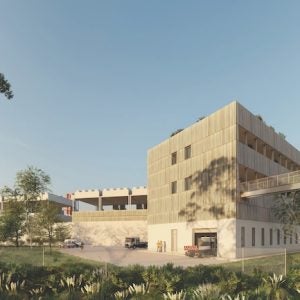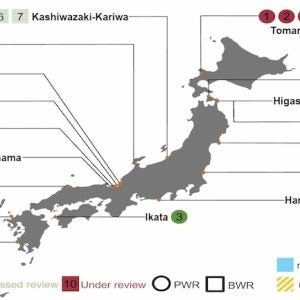Land based heavy duty gas turbine (HDGT) technology has been greatly influenced by aero engine (AE) design, driven by performance and fuel efficiency improvement objectives. Notably, turbine inlet temperatures employed in land based heavy duty gas turbines have increased markedly. Figure 1 compares the turbine inlet temperature trajectories for land based heavy duty gas turbines and aero engines spanning eight decades.
The present turbine inlet temperature levels in HDGT engines are either at, or above, the melting point for most materials that are typically employed for blades, vanes and seals. Therefore, advanced heat transfer techniques and increasingly complex secondary air- cooling system (SAS) circuitry have become essential for maintaining hardware within safe metal temperature limits over long operating periods between scheduled overhauls, with no untoward incidents.
Primary role for secondary air-cooling
The increasing importance of secondary air- cooling systems is illustrated by the Row 1 blade example shown in Figure 2. It is interesting to note that Row 1 blades were uncooled prior to 1971 and therefore, SAS was a rather insignificant design consideration up to that time. Initially, internal air-cooling was applied to Row 1 blades, using radially oriented holes that ejected the cooling air through the blade tip. As turbine inlet temperatures continued to increase, the internal cooling schemes have become more sophisticated with impingement and film cooling techniques, and more pervasive presence of cooling holes on airfoil surfaces that come into direct contact with combustion gas effluents. Also, more turbine hot section surfaces, eg, those of blade airfoils, vane airfoils and side walls, seals, and blade shrouds, have required the protection of internal air-cooling schemes to keep them within safe metal temperature limits.
As a result, the scope and complexity of SAS have continued to evolve due to increased heat flux with successive generations of heavy duty gas turbine technology.
It is clear that secondary air-cooling system integrity is crucial for long term operation of modern gas turbines (F class upgrades, H and J) and protection of combustor, turbine and rotor components. To achieve this successfully, the SAS must be able to provide cooling air jet streams that eject outward into the gas path and preclude the build-up of rust/fine dust/CMAS (calcium–magnesium alumino–silicates) matter at cooling holes.
This may be particularly challenging in the case of unsteady transient load adjustments arising from fluctuating renewables on the grid, due to greater head loss and energy dissipation, and compounded by ever longer maintenance overhaul intervals.
As turbine inlet temperature levels continue to increase with evolving technology, the cooling air supply distribution network must be extended to protect additional downstream locations in the turbine and rotor bore subject to the effects of greater heat flux. In the latest, 1650°C class, of land based gas turbines, Row 4 blades require internal air-cooling. This introduces new challenges for manufacturing (ie, for suppliers of investment casting), and uncertainty pertaining to creep-rupture life capability. For example, the accurate positioning of radial cooling holes in the thin-cross-section blade camber line becomes more complex due to thermal bowing and distortion, presenting a manufacturing challenge in terms of consistently locating cooling-holes in successive blades.
Also, estimating creep rupture life for the cooled Row 4 blade requires tight control of cooling air supply and resulting cooling effectiveness. In other words, the cooling air supply to the Row 4 blade must adapt effectively to thermal load profile variations in the gas path. Creep life prediction methods must accurately reflect the manufacturing (hole location variance) and cooling (gas profile variation) uncertainties in calculating local and bulk creep-strain limits. Blade life may be reduced by half if the metal temperature prediction is off by only 27°C (50°F). Another issue to contend with is that the design architectures incorporated in many of the advanced technology upgrades represent significant changes from the reference benchmarks and field experience knowledge. In addition to the example of the Row 4 blades that now require internal air-cooling, in some of the F-class upgrades and more advanced 1650°C class of gas turbines, we are seeing changes in the number of turbine stages (in some designs), resulting in changes in disc cavities/shapes of disc cavities and rotor cooling air schemes, new ideas for reducing leakage losses such as smooth (ie, continuous) rotor hub surfaces with rotating seals, changes in rotor architecture and blade locking schemes, changes in exhaust diffuser schemes, amongst other things. However, there is no demonstrated benchmark to judge whether the design assumptions and design criteria (strain limits) for random cyclic load dispatch mode are accurate to endure through the service replacement interval, with no untoward incidents.
Inspection intervals and corrosion resistance
The nearest domain experience pertaining to effects of random and uncertain load dispatch mode on component damage accumulation assessment is that of military engine hardware vis-a-vis commercial engines. Both military and commercial aero engines apply similar design methods, materials, manufacturing, and assembling practices, but the major overhauls are performed more frequently for military engines, eg, around 2000 hours versus about 15 000-20 000 hours for commercial engines. Ironically, HDGT maintenance inspection intervals have actually become longer than used to be the case when the machines were predominantly operated as baseload (ie, with significantly less severe creep-fatigue loading effects).
The traditional practice of performing annual or intermediate maintenance overhauls for the combustor hardware has been eliminated in some of the new land based heavy duty gas turbines in the industry. Instead of the prior practice of performing combustor maintenance overhauls at intervals of 8000 hours (and at 16000 hours in some of the later evolutions), the combustor overhauls are now merged with the turbine (hot gas path) maintenance overhaul at 32 000 hours, 1200 starts.
Fleet data for older-technology aero-derivative, E-class and F-class land based heavy duty gas turbines, obtained via Strategic Power Systems, show that the maintenance overhaul interval (ie, demonstrated capability) was around 17 000 hours for E-class, and around 20 000 hours for F-class (older models). So, it appears that the 32 000 hours capability claimed for new models may be over-optimistic, considering that the alloy compositions employed in the older E- and F-class engines had better corrosion resistance (with around 14-17% chromium), than the present type of base metals (about 6% chromium) employed in F-class technology upgrades, and advanced engines.
Until these corrosion resistance issues are addressed adequately, interim solutions may be necessary to address the severity of submicron particle ingestion into the engine, eg via deployment of additional inlet-air filters in the SAS network and adoption of a preventative maintenance regime that accounts for differential pressure losses in the SAS network, analogous to the system equilibrium in a spiderweb.
It is also worth noting that older blade casting technologies were more amenable to the extraction of entrapped fine dust and rust matter inside the blade cavities because the tip-caps were removable during refurbishment. However, that is not feasible with current casting technology because the tip is cast integrally with the rest of the blade body. As a result, it is physically impossible to remove entrapped matter located inside more intricate internal cooling passages and impingement cooling-holes that are located inside those cavities. Likewise, removal of diffusion layers of oxidised (hot sulphidation) microstructure is more complex for the same reason. Therefore, ensuring proper flows and cooling effectiveness after refurbishment poses challenges, in particular considering that the integrity of the TBC overlay is dependent on the ability to control thermal expansion mismatch strains between the base metal and TBC layer.
Insufficient validation
A general practice in the gas turbine industry is to claim that new product introduction (NPI) reliability is “supported by the cumulative historical track record of prior evolutions”, or words to that effect. However, this may be misleading in the context of advanced land based heavy duty gas turbines because successive design upgrades involve an ever widening gap between turbine inlet temperature and the safe metal limit, necessitating further significant changes to the secondary air-cooling system, and various other structures (eg, exhaust diffuser), relative to the prior engine version, due to more severe heat flux exposures, and consequent need for additional cooling air protections to locations farther downstream in the turbine, rotor bore, and exhaust diffuser.
The current design evolution trajectory may not be adequate for reliably protecting the many engine components that depend on internal air-cooling supply for sustaining safe metal temperatures over their design life (ie, over a number of years). The secondary air-cooling system must provide margins of protection that are relevant for the limitations of land based heavy duty gas turbines rather than aero engines. The ability to cope with poor local environmental conditions and widely varying fuel quality, with good corrosion resistance, is an essential requirement for land based gas turbine operation. This has been compromised, with the latest machines proving less robust relative to earlier evolutions of the land based heavy duty gas turbine.
The present 8000 hour engine validation is insufficient for determining advanced technology gas turbine reliability, and especially for making a realistic assessment of the protection cababilities of the secondary air-cooling system. As a result, projections for performance degradation, engine reliability, availability, maintainability and levelised cost of electricity (LCOE) tend to be misleading. Therefore, NPI engine validations must unequivocally demonstrate that the secondary air-cooling system functions reliably over at least one scheduled maintenance overhaul interval, with no untoward incidents encountered anywhere in the engine, including compressor inlet manifold and turbine exhaust discharge section, as well as in the gas turbine itself.
Aero engines vs land based heavy duty turbines: design tolerances
Rotor architecture
The typical rotor geometries in aero engines and land based heavy duty gas turbines are very different, although many of the ideas for the compressor flow path, turbine flow path and secondary air-cooling systems are now very similar for both types of engine.
In the aero engine industry there are either two or three spools that are decoupled, and rotate at variable speeds. Heavy duty gas turbine rotors are single spool and have a fixed speed of 3000 rpm or 3600 rpm because it is dictated by the power grid frequency. The diagram above right shows layouts for two typical aero engine rotor architectures. The bleed extraction piping sizes in aero engines are smaller because the bleed extractions are tapped from the LP and HP compressor sections. As a result, the variable speed aspect enables better modulation of flow rates inside the bleed piping that feeds the secondary air-cooling system distribution network to the various items of hot gas path hardware, turbine rotor disks and seals. Likewise, there is comparatively less head loss, less energy dissipation associated with flow separations, recirculation, and less overall friction losses pertaining to the transport of cooling air from the compressor bleeds to the hardware in the turbine and rotor sections that requires internal cooling for safe operation. Therefore, there is a better ability to balance the fluid properties (density, pressure, kinematic viscosity) and flow rates inside the secondary air-cooling system air supply distribution network, with the corresponding fluid properties in the main flow path, particularly during frequent load adjustments.
Overall, there is a better ability to modulate Reynold’s number, and to avoid negative flows from the hot gas side into cooled hardware because of better ability to control of inertial effects and eddy losses in the secondary air-cooling system circuit. This aspect of secondary air-cooling system functionality is vital for sustaining jet ejection from inside the blade (and rotor disc) internal cavities to the hot gas path side, throughout the random, wide ranging and frequent load changes associated with renewable load fluctuations on the grid.
The secondary air-cooling system supplies cooling air to the various hot gas path components in the turbine section (blades, vanes, heat shield, seals), and also to the various rotor disc cavities and disc root locations (fir-tree blade attachment).
The lack of a similar variable speed operability for the land based single spool heavy duty gas turbine rotor makes it harder to control residual swirl angles, flow separations and vibration amplitudes particularly during transients and extended operation part load conditions, due to issues such as residual swirl and vibration consequences on structures that house the rotor bearing struts, at the compressor-inlet and turbine-exit locations.
Propensity for entrained matter inside the engine
There are vast differences in the compressor material systems employed in aero engines and land based heavy duty gas turbines. Aero engines predominantly use nickel and titanium alloys for rotating hardware (disc and blades), stationary hardware (airfoils and casings) and bleed extraction piping, in comparison to ferrous alloys for those same applications in land based machines. Overall, the pressures and temperatures inside current technology land based heavy duty gas turbines are comparatively greater than in previous technology, and more liable to promote greater oxidation and corrosion (rust in the form of haematite and magnetite). Therefore, the present direction of technology upgrades can be expected to introduce fine rust particles into the primary and bleed air extractions that supply cooling air via the secondary air-cooling circuit to the various items of air-cooled hardware in the turbine section and rotor.

Propensity for fine, submicron particles from the environment
In general, environmental conditions are harsher for ground installations than those at high altitude, and land based machines experience higher concentrations of fine dust, sand, salt, ash, pollen, moisture, smoke, etc.
Additionally, land based gas turbines can be exposed to sporadic weather conditions such as sand storms, rain storms, lightning, hail, etc, that add to overall inlet-air filtration challenges, and fine particulate matter smaller than the inlet-filtration capabilities cannot be prevented from entering the engine during operation.
Due to the significantly greater inlet-air swallowing rates and very high velocities found in current land based heavy duty gas turbines, the concentration of ingested matter tends to be greater than experienced with previous compressor technology. Advanced compressor technology tends to be more susceptible to fast performance degradation associated with fine particle ingestion, impact damage, fouling, friction, erosion and abrasion of the coated surfaces inside the compressor. However, countermeasures such as water washing may not be performed as often for land based machines as they are for aero engines due to the potential for long disruptions to power plant operation.
Turbine alloys with less corrosion resistance
Several advanced technology land based heavy duty gas turbines in the industry have adopted aero engine alloys for blades, vanes, heat shields, and seals that are optimised for stronger oxidation resistance, but are relatively weak in terms of corrosion resistance. This is because the alloy compositions have low chromium content. Laboratory tests have shown that alloys such as IN738, IN939, X45 and MarM509, which are relatively chromium rich (Cr around 14 to 22 %), have better corrosion resistance than the alloys with less chromium content currently employed in many land based heavy duty gas turbines. Therefore, the non-gas path surfaces inside the blade/vane/seal cavities of these turbines are more vulnerable to hot sulphidation attack due to weaker corrosion resistance against fine dust particles or other contaminants that may enter land based engines from the environment and fuel streams.
Fuel constraints
Aero engines can only run on jet fuel with tightly controlled fuel composition restrictions, whereas land based gas turbines may be called upon to operate with a wide range of gaseous and liquid fuel options, eg, distillate diesel, crude oil, vacuum residue liquid fuels, natural gas, low CV waste gases, blast furnace gas syngas, etc. Therefore, land based heavy duty gas turbine fuels are generally more corrosive than aero engine fuels, but less corrosion resistant material systems are being increasingly used in F-class upgrades and advanced land based gas turbines.
Above Image: Typical multi-spool rotor architectures in the modern high bypass ratio turbofan aero engines (source Sait Aksoy, AeroJetMotor Corp, Woodbridge, CT, USA)
Authors: Vinod Kallianpur and Yosun Shin Samsung C&T, Sangil-dong, Seoul, Korea






